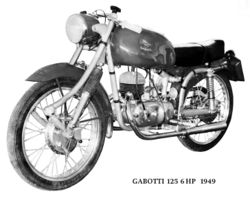Difference between revisions of "Gabotti"
m |
m |
||
| Line 12: | Line 12: | ||
'''Gabotti''' was founded by [[Enzio Gabotti]] who started his career at [[Sertum]] [[motorcycles]] in [[Milan]] before the 2nd WW. After the war he moved to [[Rimini]] on the Adriatic coast and started his own workshop with building about 75 125 cc and 150 cc two stroke motorcycles during the period between 1949 to 1950's, although some were being sold off in later years. He tried to unite all what was best in Italian design and technique. Front fork was a la Guzzi Gambalunga and the rear suspension was copied from the [[Gilera]] system. Engine was poached from [[Lambretta]] and [[MV Agusta]] in 3 speed Turismo and 4 speed Sport version. A competition version, derived from the Sport, was made for the Milano-Taranto long distance race and measured 53x56 mm, 6 BHP at 6000 RPM, compression 8:1, available top was 60 MPH. | '''Gabotti''' was founded by [[Enzio Gabotti]] who started his career at [[Sertum]] [[motorcycles]] in [[Milan]] before the 2nd WW. After the war he moved to [[Rimini]] on the Adriatic coast and started his own workshop with building about 75 125 cc and 150 cc two stroke motorcycles during the period between 1949 to 1950's, although some were being sold off in later years. He tried to unite all what was best in Italian design and technique. Front fork was a la Guzzi Gambalunga and the rear suspension was copied from the [[Gilera]] system. Engine was poached from [[Lambretta]] and [[MV Agusta]] in 3 speed Turismo and 4 speed Sport version. A competition version, derived from the Sport, was made for the Milano-Taranto long distance race and measured 53x56 mm, 6 BHP at 6000 RPM, compression 8:1, available top was 60 MPH. | ||
| − | Later models were to have conventional swing arm rear [[suspension]] and the special front fork arrangement was built by [[Fratelli Moroni]]. However the model shown here never passed the prototype stage. [[Gabotti]] quit bikes and went into woodworking machines in which the company still flourishes today. But Enzio had one last trick upon his sleeve. He proposed a 175 cc racer, more or less based on the [[MM]] design, but it got only as far as producing just one engine. A complete racer never saw the light of day. <sup>Info and Phots by Theo Jonkhart</sup> | + | Later models were to have conventional swing arm rear [[suspension]] and the special front fork arrangement was built by [[Fratelli Moroni]]. However the model shown here never passed the prototype stage. [[Gabotti]] quit bikes and went into woodworking machines in which the company still flourishes today. But Enzio had one last trick upon his sleeve. He proposed a 175 cc racer, more or less based on the [[MM]] design, but it got only as far as producing just one engine. A complete racer never saw the light of day. |
| + | |||
| + | <sup>Info and Phots by Theo Jonkhart</sup> | ||
Revision as of 01:58, 11 November 2010

1949 - 1950's
Gabotti was founded by Enzio Gabotti who started his career at Sertum motorcycles in Milan before the 2nd WW. After the war he moved to Rimini on the Adriatic coast and started his own workshop with building about 75 125 cc and 150 cc two stroke motorcycles during the period between 1949 to 1950's, although some were being sold off in later years. He tried to unite all what was best in Italian design and technique. Front fork was a la Guzzi Gambalunga and the rear suspension was copied from the Gilera system. Engine was poached from Lambretta and MV Agusta in 3 speed Turismo and 4 speed Sport version. A competition version, derived from the Sport, was made for the Milano-Taranto long distance race and measured 53x56 mm, 6 BHP at 6000 RPM, compression 8:1, available top was 60 MPH. Later models were to have conventional swing arm rear suspension and the special front fork arrangement was built by Fratelli Moroni. However the model shown here never passed the prototype stage. Gabotti quit bikes and went into woodworking machines in which the company still flourishes today. But Enzio had one last trick upon his sleeve. He proposed a 175 cc racer, more or less based on the MM design, but it got only as far as producing just one engine. A complete racer never saw the light of day.
Info and Phots by Theo Jonkhart
Send what you have to:
| Motorcycle Information and Photos by Marque: A - B - C - D - E - F - G - H - I - J - K - L - M - N - O - P - Q - R - S - T - U - V - W - X - Y - Z |
| Car Information and Photos by Marque: A - B - C - D - E - F - G - H - I - J - K - L - M - N - O - P - Q - R - S - T - U - V - W - X - Y - Z |

